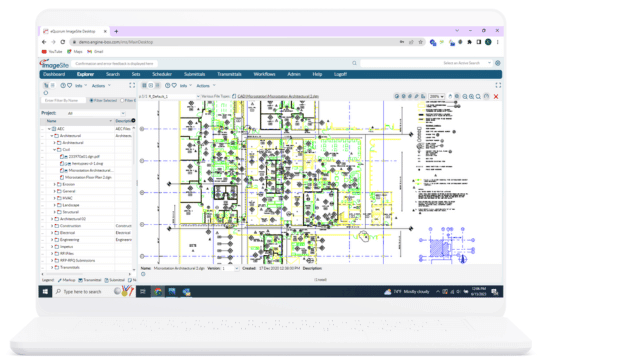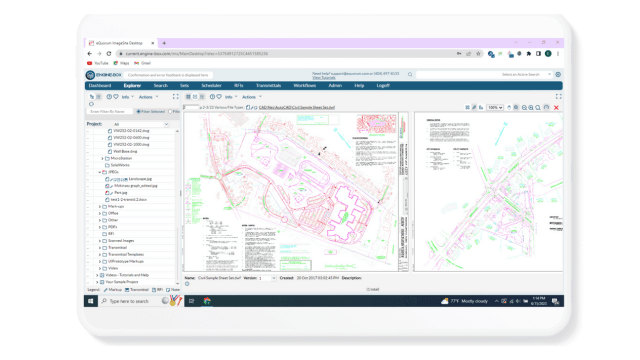Engineering Workflow and Document Management Industry Trends for 2025
Engineering Workflow and Document Management Industry Trends for 2025
The future of engineering document and workflow management in 2025 is expected to be shaped by advancements in several key areas, driven by technological innovations and evolving business needs. The global document management market is predicted to grow to $14.29 billion by 2029, with a compound annual growth rate (CAGR) of 14.5% from 2024 to 2029. The workflow automation market, which overlaps with document management, is valued at USD 14.99 billion and is projected to reach USD 71.03 Billion by 2031, growing at a CAGR of 23.68% from 2024 to 2031.
The combined market for both document management and workflow automation is expected to show rapid expansion as businesses increasingly digitize, and automate their operations. Due to increasing digital transformation initiatives, a shift to cloud-based solutions and the rise of automation and AI technologies. Here are a few significant trends and developments that will likely define the industry in the coming years.
Here are EDMS Industry Trends we believe will pave the way in 2025
- Intelligent workflows
- Voice-activated Document Management and Natural Language Processing (NLP)
- Mobile Remote Access
- Sustainability Considerations and Carbon Footprint Tracking
- Advanced Analytics and more Profound Insights
- Automated Compliance and Regulatory Focus
- Simplified Interfaces and Personalized Workflows
- Integration with Other Technologies
An increase in AI and automation integration will create intelligent workflows
Artificial intelligence will impact document management by enhancing user indexing, categorization, and search capabilities. AI will be used to extract and process data from various document types, including drawings, specifications, and forms, enabling organizations to experience faster time and improved accuracy. Overall, AI will automate manual repetitive engineering tasks, such as document indexing, design analysis, and data extraction, saving time and reducing human error.
Workflow automation will increasingly use AI to predict, automate, and optimize business processes.
Smart workflows can adjust in real-time based on incoming data or unexpected changes, allowing organizations to restructure processes without human intervention. These more intelligent workflows will also restructure engineering processes, enabling faster project execution, reduced rework, and better decision-making.
Voice-activated document management and Natural Language Processing (NLP)
Voice interfaces, powered by NLP, will allow users to better manage documents and workflows hands-free, improving accessibility and efficiency, especially in plants, on the production floor, and in the field. Voice-activated systems will enable engineers and technicians to quickly search and access documents and drawings, perform tasks hands-free, and enhance accessibility, primarily on-site or in environments where manual interaction is complex.
NLP will continue to evolve, enabling systems to better understand the context and meaning of documents and searches. This will allow for more automated actions based on document content. NLP will improve document searching and automated document generation, streamlining engineering processes like change order creation or specification updates.
Cloud adoption will continue to rise, promoting mobile remote access
Businesses are increasingly shifting to cloud-based platforms to help manage and store their documents, drawings, and files. This shift allows for greater scalability, flexibility, cost-effectiveness, and real-time access to documents and drawings from anywhere. Mobile document management and workflow solutions will become increasingly important as remote work continues to rise.
Integrating mobile and cloud technologies will facilitate remote management of workflows, enabling business continuity in distributed work environments. These solutions allow employees to access, review, and edit documents from mobile devices, ensuring that workflows are not disrupted outside the office. Cloud-based systems with mobile access to documents and workflows will allow engineers and project managers to access and collaborate on design documents and CAD files and to review and approve designs, access data, or make decisions while on-site or working remotely from any location. This flexibility will improve responsiveness and operational continuity while facilitating collaboration between field engineers and project managers.
Sustainability considerations and carbon footprint tracking
Document and workflow management systems will assist engineering and manufacturing firms in meeting their sustainability goals by allowing them to track and manage the environmental impact of document processing, reduce paper usage, and enhance their sustainability practices. Furthermore, monitoring the carbon footprint of engineering projects supports organizations in aligning with environmental objectives and meeting their sustainability targets.
Advanced analytics and more profound insights
Document management systems will incorporate data analytics tools to offer deeper insights into compliance, document usage, and workflows. These tools will help organizations ensure better compliance with regulatory requirements, identify bottlenecks, and streamline workflows. Advanced analytics will provide insights into engineering workflows, helping identify inefficiencies or risks early in the design, manufacturing, or production/construction stages.
Predictive capabilities will allow businesses to anticipate delays or inefficiencies in workflows and proactively address them before they impact operations. Predictive analytics will help optimize resource allocation, anticipate delays, improve overall project timeliness, and reduce overall rework.
Automated compliance and regulatory focus
With ever-evolving regulations in security and industry sectors like finance, healthcare, and legal, automated compliance features will become essential.
Document and workflow management systems will be equipped with tools to automatically flag non-compliance issues, ensure proper document retention, and generate reports for audits.
As data breaches become more sophisticated, the security of documents and workflows will remain a key concern. With the upcoming promulgation of CMMC requirements, security requirements will be greatly enhanced, and companies providing services to the government or government contractors will have much higher standards to meet.
Document management systems will maintain the integrity of sensitive data by employing advanced encryption, biometric authentication, and multi-factor security measures as standard practices. Automated compliance tracking will ensure engineering projects adhere to industry standards and regulations, minimizing the risk of costly penalties or project delays. This type of compliance tracking is significant in regulated industries such as architecture, engineering, construction (AEC), utilities, and aerospace engineering.
Simplified interfaces and personalized workflows
Complex document and workflow management systems will feature more intuitive and user-friendly interfaces that will reduce the learning curve and enhance employee adoption rates. The importance of the user experience will grow significantly. More intuitive document management and workflow systems will reduce the learning curve for engineers, allowing them to focus on their work rather than technology and manual document organization. Personalization will also extend to workflow management. Systems will adapt to individual user needs, preferences, and past actions, optimizing workflows to the user's habits for maximum productivity (e.g., knowing the preferred search criteria). Personalized workflows will adapt to engineers' preferences, enhancing productivity and user satisfaction.
Integration with other technologies
The Internet of Things (IoT) will enhance document and workflow management in manufacturing by using sensors and devices to generate data, automatically improving operational efficiency. Integrating Robotic Process Automation (RPA) into document management systems will also automate tasks like data entry, document classification, and approvals. This will streamline project management, saving time and reducing human error.
By 2025, document and workflow management will be characterized by greater automation, more intelligent systems, and deeper integrations with AI, cloud technologies, and other emerging production tools. These systems will reduce manual work, improve efficiency, and enhance security, compliance, and employee collaboration. As businesses increasingly rely on digital workflows, the ability to adapt to remote work environments, improve user experience, and integrate new technologies will be key differentiators for leading organizations.
Cloud DMS Features
Our EDMS solutions
ImageSite and EngineBox are eQuorum’s robust workflow and document management solutions, created to help workers manage their essential workflows while maintaining complete control over their engineering files and documents. Not only do they provide a secure collaboration site for workers, but they also help organizations manage document distribution with third parties like vendors, contractors, and customers. Both systems are offered at a competitive price, enabling organizations to get a quick return on their investment by providing the features and functionality needed to help organizations improve efficiency, productivity, and collaboration. Companies can choose from concurrent user subscriptions or named user subscriptions, ensuring organizations have subscription options that make sense for their business.

ImageSite®
Our single source engineering workflow and document management system. Built in HTML5 so there is no software to deploy to client computers or mobile apps to download. Offered as an On-premise or Private Cloud system.
EngineBox™
EngineBox is a cloud based workflow and document management version of ImageSite that resides outside the corporate network.
Our EDMS solutions
ImageSite and EngineBox are eQuorum’s robust workflow and document management solutions, created to help workers manage their essential workflows while maintaining complete control over their engineering files and documents. Not only do they provide a secure collaboration site for workers, but they also help organizations manage document distribution with third parties like vendors, contractors, and customers. Both systems are offered at a competitive price, enabling organizations to get a quick return on their investment by providing the features and functionality needed to help organizations improve efficiency, productivity, and collaboration. Companies can choose from concurrent user subscriptions or named user subscriptions, ensuring organizations have subscription options that make sense for their business.

EngineBox™
EngineBox is a cloud based workflow and document management version of ImageSite that resides outside the corporate network.
The eQuorum Customer Promise
In 2005, eQuorum developed the first all browser-based EDMS. The system, although for on-premise use, was still created to remove client software and JAVA from user computers and allow users to have a single viewer based on the simple navigation functionality of browsers. Today, eQuorum provides that same application in a private Cloud or a SaaS Cloud option. We can do this because we are, and have always been, browser-based, understanding the enhanced speed, security, and usability of this technology.
With the abundance of document management systems on the market today, there’s no doubt that choosing the right Cloud document management software can be a difficult decision. eQuorum is here to provide a comprehensive, powerful, and most importantly – affordable Cloud document management solution. We believe in providing real value to our customers by eliminating unnecessary costs, providing industry-leading functionality, and equipping your team with the right tools using cutting edge technology to bring your products to market faster.
eQuorum®
We specialize in engineering workflow and document management. Our comprehensive, yet easy-to-use software provides the solution to manage data from design to manufacturing and production, to sales, support and administration.